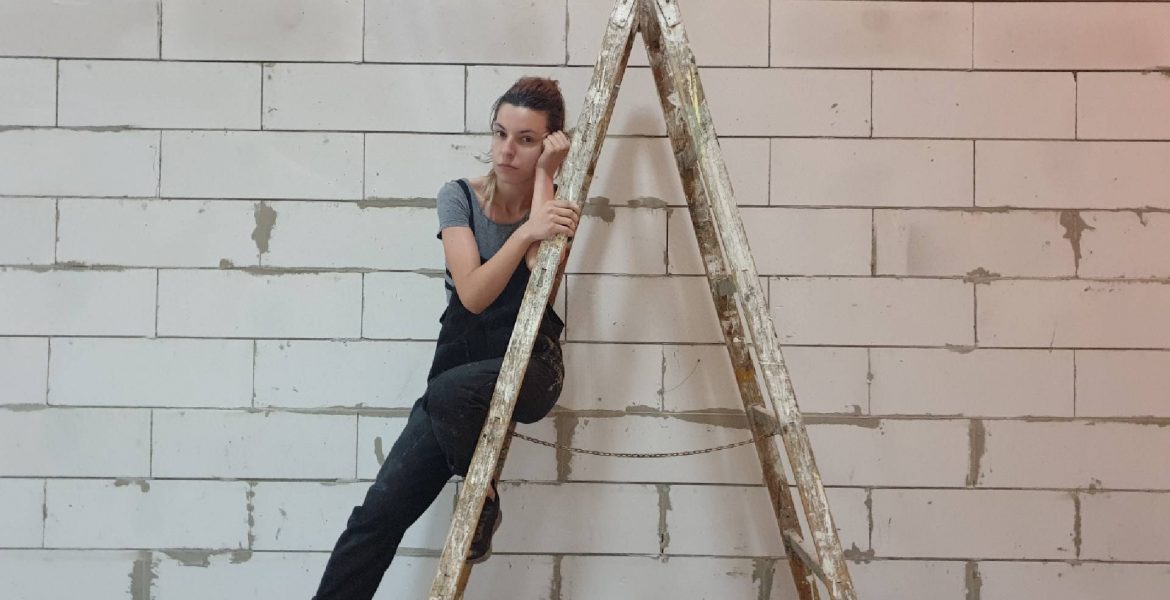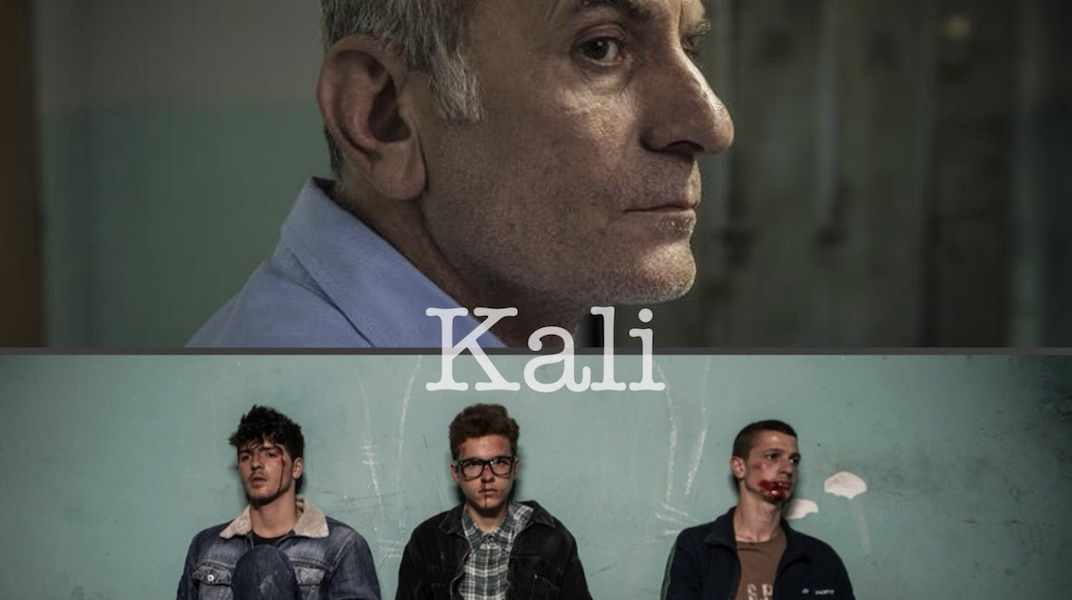Adna Muslija is a young visual artist who believes culture to be a part of our identities. Her work aims to show that art is far more than a pastime; it makes us reflect on, examine and reexamine our own limitations.
In the interview for the uKONTAKTu portal, she spoke about the two-galleries-under-the-same-roof phenomenon, the walls that were and are still being built, the need to tear them down, about elitism in art and various other issues.
How did it all start with you and art?
As a little girl in kindergarten, I told my parents I was going to become a painter. My uncle is a painter and he has always been my greatest role model. So I first started drawing. And I have never stopped drawing ever since. In my fourth year of grammar school, I started having some crazy ideas about studying mechanical or electrical engineering… My Dad told me that my chances to enroll in such a programme were equal to his chances of enrolling at Hogwarts. That was probably his way of telling me that, far from being unable to do things and take on “a man’s job”, I should just stay true to my own dreams and desires and that meant enrolling at the Academy of Fine Arts. So I enrolled at the Academy, the Department of Art Education and later graduated and obtained my master’s degree, majoring in Painting. While still an undergraduate and later as a postgraduate student, I took up installation and other media besides drawing and painting. That is how I started researching other art media and I am still developing and growing. It is really a never-ending process.
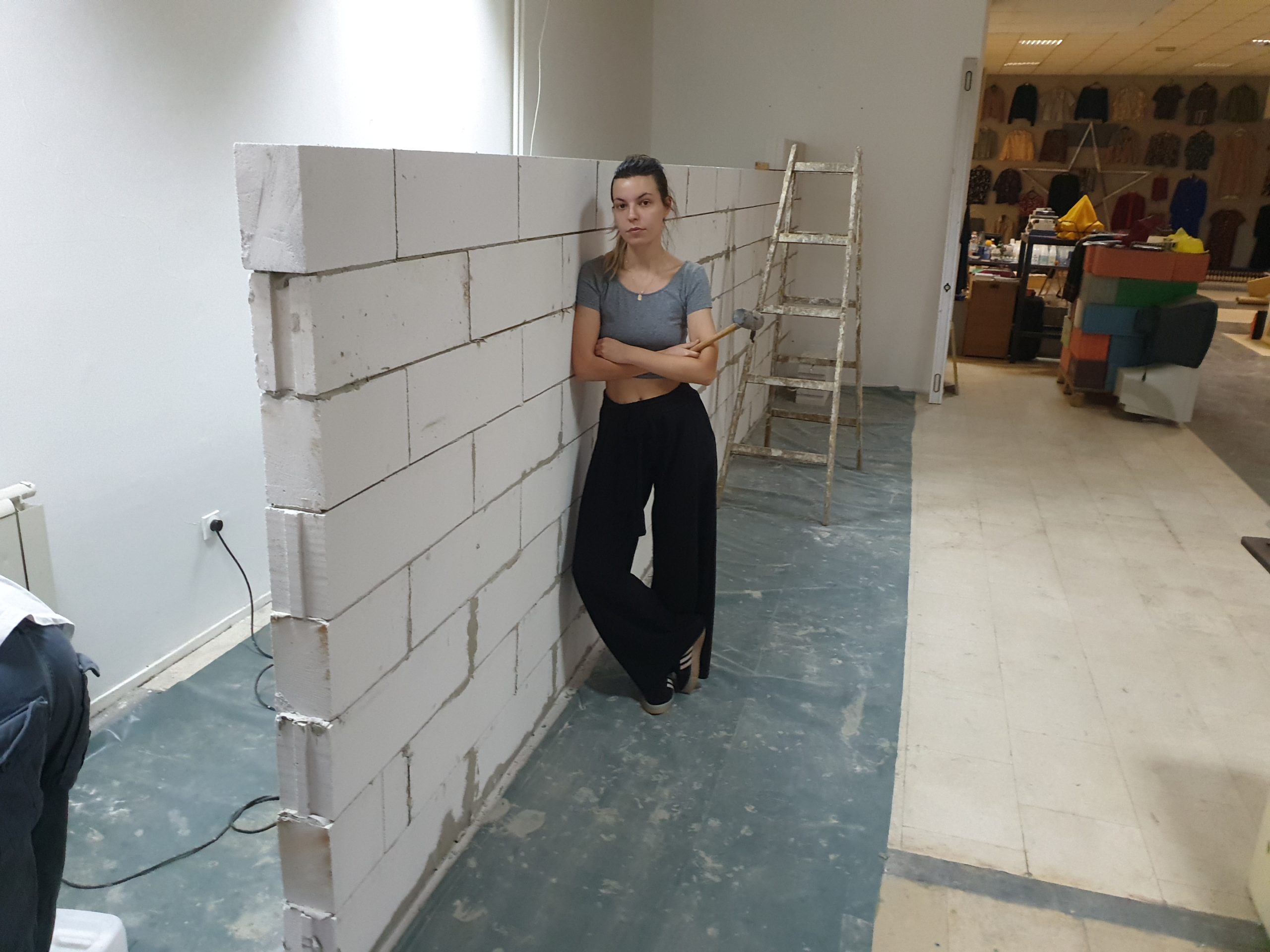







How did the people around you react to the fact that you enrolled at the Academy, bearing in mind that professions here are very often valued and ranked? In particular, professions related to art are deemed as not being the bread-earning kind.
All my friends, people who matter to me, they all knew I was going to enroll at the Academy and supported my decision. My parents are a rare example and the kind of parents who would never try and dissuade their children from an artistic career, on the contrary. Indeed, I have never felt that there was either astonishment or antagonism towards this profession – I was fortunate and privileged to be supported by all – my brother, my parents and my friends.
How much room, if any, do young artists like yourself have on the art scene in our country?
You have as much room as you yourself manage to obtain. Generally speaking, there is not enough room for the experienced, established artists, let alone the young ones. Take one look at the cultural institutions and you will see that they are barely getting by. Consequently, we are all barely getting by. It all depends on our individual wish to create and to work on something. My colleagues and I are collectively trying to create a space for the future and that is why we decided to found a gallery of contemporary art Manifesto, which will soon have its own premises. Up until now, it has functioned as a nomadic gallery, using the premises of other institutions, public areas, etc., but this time we are testing the idea of our own space. We have a vision in which we trust and we therefore hope for success.
In August last year, in the spatial symbiosis of the Charlama and Zvono galleries, you presented your processual site-specific work titled “The Demarcation Line” which ended by tearing down the wall you built. What was the main trigger for this work?
It all began with me getting in touch with Saša Bukvić for reasons completely unrelated to my art practice. As an Art History and Comparative Literature student at the Faculty of Philosophy, I was writing a paper about the Zvono art group. I got in touch with Saša to obtain more information as I had very little to work on. He asked to see some of my work and liked the artwork created as part of my diploma thesis. We had initially agreed to an exhibition, but when I came home, I started thinking about the two-galleries-under-the-same-roof phenomenon, which Zvono and Charlama really are. I thought that it would be a great pity not to dedicate a special piece of work to it in order to draw people’s attention as this phenomenon represents a true manifestation of solidarity on Bosnia and Herzegovina’s art scene and could serve as an inspiration and role model for other people and professions. I suggested building a wall and Saša instantly warmed up to the idea. And so I started building this wall, brick by brick, with emotional and physical support of people who were then visiting the gallery.
Transferring the exhibits of the Zvono Gallery to the walls of the Charlama Gallery was a result of the coronavirus pandemic and the economic crisis that ensued. As it happens, in times of crisis, culture is always on the front lines of impact. The drastic cuts of the Federal budget allocated to culture at the beginning of the pandemic confirm this statement. It is as if there was a wall between culture and art on the one hand and the authorities on the other. How was this wall erected?
I think we have walls standing between all the institutions in all the fields of human endeavor. This is not just an art-related phenomenon. On the one hand, those walls are a result of administrative divisions as we happen to have a very complicated bureaucratic system; so, every time you want to do something, there are just too many obstacles of that sort. On the other hand, there are a number of other obstacles which are, in fact, psychological – people themselves have created them in their heads and so they apply them in their practices. By tearing down the wall at the gallery, my aim was to show how much time it takes to build a wall and how quickly it could be torn down if people gathered around a common goal – to tear it down. Thus, the wall that took ten days to build was torn down in ten minutes. For me, that was a specific point of the performance and something that I emphasize throughout my work – walls are easy to tear down – it is much more difficult to build them. People tend to think it is the other way round but all we need is a change of perspective.
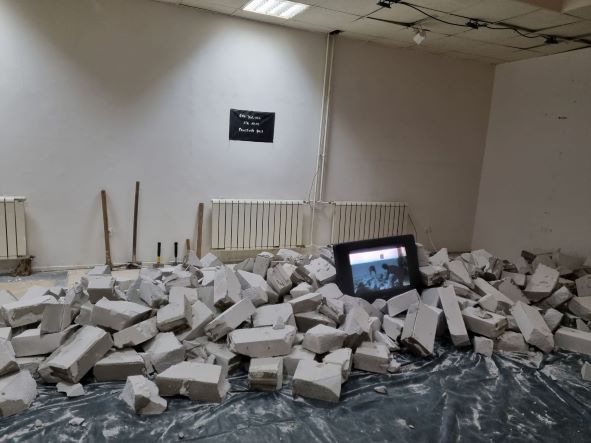







You were also the curator of the “Dear Santa Clause” project authored by the young artist Kemil Bekteši. The project was dedicated to the non-existent walls of the Ars Aevi. Both this and your own project “The Demarcation Line” speak about the fact that art is here on the verge of existence. Bearing in mind that the power of art is reflected in its capability to raise awareness in society, how did we come to the point that there is so much animosity on the part of the authorities and art institutions towards art?
Those are the walls that were being built for ages. I think that our education system played a major role here as the people who are in power right now were being educated right before and during the war. Those people are not qualified for the positions they hold and hence lack the expertise to allocate the funds they have in their budgets. That is one of the reasons; the other reason is that there is an established view that there are far more important things than culture. Of course, there will always be one thing which is more important than the other, but people fail to realize that culture is not just some decoration for certain individuals to play with from time to time; culture is a part of our identity. Art always has a subversive and progressive potential. It has the capability to pinpoint some new perspectives and new narratives, of which the society we happen to live in – one which is mostly nationally and ethno-deterministically oriented – does not approve. Hence, it is logical that a culture that undermines such a system and raises people’s awareness is not to be invested in. Citizens who are critical thinkers with conscience and self-awareness are not in the interest of authorities. They strive to create a population living on the verge of existence, one day at a time, and are just happy to be getting by. It is as simple as that, they do not want people who think for themselves and who strive to enrich their lives with something involving more than mere survival.
Does it have to do with the fact that in early education, school subjects such as art and music are regarded and ranked as subjects which are less important than others?
That is an issue of how art subjects are designed in primary and secondary schools. Children are expected to meet some standard criteria which essentially do not contribute to their affective sphere of personality. Bearing in mind that I am an Art teacher, I believe that Art is not about knowing the names of ten impressionists; Art should entice creativity in children, boost their visual sensibility and their sense of aesthetics; it should break the preconception that one should be talented in drawing in order to love art. This is a major prejudice that many people have, not just in Bosnia and Herzegovina but in the world. Creativity is something we nowadays cannot live without – whatever you do, being creative is a prerogative. For every job you apply for, it is required that you should be flexible and creative and those are the skills developed and nurtured by artistic school subjects. The entire setup and grading criteria of those subjects are just wrong. I do not wish to imply that students should not know the primary colors or who the impressionists were, far from it. That is useful general knowledge, but I just don’t think that the grading criteria should be based on whether a child drew an apple the right way or not. It is precisely this that generates a series of aversions towards art and efforts should definitely be made to change this.
In your view, to what extent do young people who are not involved in culture and art take interest in such issues?
There is a small critical mass of people trying really hard to support the art scene, particularly its young representatives. Those are some of our friends who, not being artists themselves, love and appreciate art, whether for our sake or because they have always appreciated it. There is always an initiative that young people should have their own space in which they can spend their time, be inspired, discuss topics outside the daily political range, find motivation to confront their issues, but we are talking about a very small number of people and we can therefore hardly expect them to be the critical mass required to change things. In order to change the situation, there needs to be a political will. And it is much more than just political will, it is ideological will. I believe righteous ideologies are what we need as those that we currently have seem to be nationalist ideologies. People who are engaged in politics have no ideological awareness whatsoever – they perceive everything as some sort of a business and that is why we cannot move forward. Ideology, whatever it may be, always envisages a vision and the visions which are currently projected at us, precisely due to the dominant nationalist ideologies, are far from good. That is why we are often pessimistic and stressed out.
Is there a demarcation line between the young people who are not interested in these issues and those like yourself and other young artists?
There is a line called art elitism. We neither invented nor created it – it is as old as art itself. However, it is up to us, a small critical mass, to at least try and push that line. It is a utopian dream to think that it will be completely eradicated, but at least we can hope to widen the circle of people who will take an interest in art. I have a number of friends who do not know anything about art, who have never been involved in it or even lack basic knowledge about art, but they started coming to exhibitions for my sake. When I talk about some of the works and when I spark their interest, they really enjoy it and they like to listen. You do not have to have any previous knowledge or interest, just allow yourself to become interested. Again, cultural institutions are key here – they need to work on their availability to citizens.

How do you reach out to citizens? Could the media provide necessary assistance to entice people’s interest in art and culture?
The media have their own programmes and columns and they report on culture and art, usually at the end of a news programme when people tend to switch to a different channel or in a special programme at ten or eleven o’clock in the evening which is hardly watched by anyone, even though certain TV channels have excellent programmes dedicated to culture. The media, television in particular, can hardly play a significant role here – they have been around for ages and they don’t seem to have made any significant contribution and it is not because they did not want to but because they simply couldn’t. I think that every institution should build its own public relations strategy and that – depending on what they have on display, whether a permanent exhibition, a temporary exhibition or else – they should try to advertise and reach out to people in various ways. For instance, they could invite schools and offer visits to children or they could invite companies to treat their workers with a visit to a museum. To conclude, it all depends on the willingness and competence of people who are in charge of these institutions to work on the popularization of art, to encourage and engage the audience.
What are your plans for the future? Are there any prospects for a new project?
My current focus is on the Manifesto art gallery. It is an idea which is a result of a joint initiative of my colleagues Benjamin Čengić, Kemil Bekteši, Ajla Salkić and myself. The idea was spontaneous as we all wanted a space to call our own. We did not get it right away, of course. For six months we were like nomads, moving from one venue to another as the opportunity arose and thinking what Manifesto should be and what would be its vision. We should soon be moving into our own space and our vision is based on what we previously discussed – to push the invisible barrier between the closed circle of art and artists and that which is deemed to be the wider audience. Furthermore, we want to engage the community, we want to discuss ideologies rather than politics and to present a narrative which is not predominantly nationalist but a counter narrative and to provide young people with a space in which they will be able to create their own specific community. We really need a space which would serve as a safety zone and in which we could think and speak loudly about our problems. I would like to thank all the people who supported us in any way. This goes to show that there are still people who believe in culture and art and who are able to recognize true values and potential.
Adna Muslija was born in Zenica in 1996. Having graduated from high school, she enrolled in the Department of Art Education at the Academy of Fine Arts in Sarajevo. She has spent one semester at the Faculdade des Belas Artes in Porto, Portugal, in the class of professor Sofie Torres Gonçalves, where she developed the project titled “The Unbearable Lightness of Painting”, exploring contemporary trends in the medium of painting and the possibilities of the ‘new’ in painting. Choosing painting as her major, she graduated in the class of Professor Iva Simcic, PhD, and defended her final thesis titled “Art as an Ideological Apparatus – Ideology as Artistic Content” in 2019. She deepened her interest in art theory and research of the role of words and text through participation in the Summer School as School program of the Center for Contemporary Art Station in Pristina, where she successfully completed the course “Inside the Language – Words and Art” under the mentorship of Sezgin Boynik. In 2019, she was named the best student of the Department of Art Education and was nominated for the annual “Alija Kučukalić” Award.
She completed her MA programme at the Department of Art Education, majoring in painting, by defending her thesis “Communicational and Semiotic Dimension of Art – From sign to Ideology” in 2020. She was awarded the Golden Badge of the University of Sarajevo two times. She is enrolled in a double-major MA programme, Art History: Modern and Contemporary Art and Comparative Literature at the Faculty of Philosophy in Sarajevo.
She has participated in several group and solo exhibitions in Sarajevo, Banja Luka, Tuzla, Belgrade, Porto and Milan. Alongside her independent artistic practice, she works within the artistic duo SINovi with Kemil Bekteši. She is a member of the organization team within KUMA International Center for Contemporary Art in Post-Conflict Societies and co-founder and curator of Gallery of Contemporary Arts Manifesto in Sarajevo.
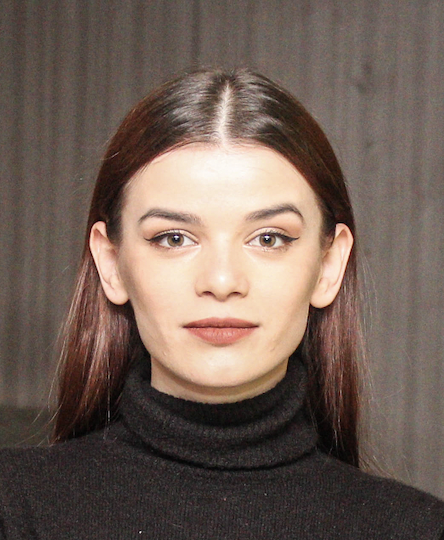
Medina Spahić was born in Gornji Vakuf – Uskoplje in 1997. Having completed her primary and secondary education in Bugojno, she graduated from the Faculty of Political Sciences in Sarajevo, the Department of Communicology in 2019. She worked part-time for the Depo.ba portal, occasionally writing for other portals as well. In the period between 2018 and 2020, she worked for the Gallery of Contemporary Art Charlama. She is currently enrolled in the Master’s Communicology programme at the Faculty of Political Sciences and works as a programme assistant at the Center for Democracy and Human Rights Education CIVITAS.
